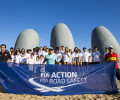FIA President discusses the new global electric race series

On Saturday, September 13 the vision of FIA President Jean Todt to create an all-electric championship will spark into life. Ahead of this historic occasion he talks about the philosophy behind the series and his hopes for the future…
Can you explain the inspiration behind setting up an all-electric championship?
The world is changing and as the sporting flagship of motorsport we have a responsibility to keep up with those changes. The link between daily mobility and racing is very important.
I thought it was important to have a vision for new technology for the development of the motoring industry and that’s why we changed the regulations in Formula 1, that’s why we supported new regulations in the World Endurance Championship. And then came the idea of making a specific flagship championship with electric technology. A lot of people were enthusiastic about this idea.
For me the electric car is really the future of motoring in the cities. And that’s why we begin with hosting races in world cities. It’s a new approach, it’s a new product.
Alejandro Agag is a very enthusiastic guy, dynamic, and has a good network so he is the ideal promoter, and that’s how it started. Anywhere I go people speak to me about Formula E with great enthusiasm and great commitment as well. You can see the cities that are committed and it’s simply amazing and those who are demonstrating an interest are also amazing. In each category: media, new media, TV, sponsors, cities, teams, manufacturers, suppliers, everybody is very excited about it.
But this is before the exam. The exam will be the first race in Beijing. We have been creating very high expectations and in life if you create expectations you must not disappoint. So that’s where we are.
How will you know if the Beijing event is a success?
I can only speak to you about expectations. About success I cannot. We need to see the first race. I will be in Beijing and hope to see an enthusiastic crowd of fans and an exciting race on the track.
Where will Formula E be in three, five and 10 years’ time?
Formula E is just beginning, and it is necessary to carefully examine the first season to see what works and what does not work. As it gains popularity and as the calendar increases, new teams and new manufacturers will be crucial. We believe we have created a framework to support the positive evolution of the series over many years, notably in opening gradually the competition between engine and battery suppliers.
Do you see technology transferring from Formula E to other FIA championships?
We can expect development in batteries, motor technology and security issues that can be transferred with other series such as F1, WEC etc.
You always learn from one championship to another one. For example, what generates a lot of cost is aerodynamic development and in Formula E it’s quite limited, which I think is a good thing because sometime you see how complicated aerodynamics are on a car. You take Formula 1 now with all the little winglets that require so much wind tunnel testing. So I would say let’s try to develop as much that can be transferred to a city car.
How does Formula E fit on the motorsport ladder or does it stand on its own?
It could be said that FE is more a stand-alone series rather than a new thread included in the single-seater ladder. However, it still does open career pathways for drivers with various backgrounds and has already attracted both young talents and experienced racers.
For me it’s a city, single-seater category, and I’m keen to keep it on a track of its own. And I think the interest in this challenge is because it’s like a circus. You have everything take place in 24 hours. The day before it’s just a normal city, then everything happens for the organisation of the race and then 24 hours later it’s just a memory until next year.
The series has the ability to reach a totally new audience…
I think it’s fascinating to see. When we speak about FanBoost – to get people participating – use your iPad, iPhone – it’s creating a link with the supporter, the team and the driver.
Some hardcore race fans find FanBoost controversial. How do you balance engagement versus the true sporting element?
For each team, each driver has to give his supporters as much support as possible, so I think it’s a friendly, fresh initiative, which I don’t think will damage the final result. I really hope it’s a category of racing which allows contact with the drivers – people love to have contact. You see that in endurance racing where you have more access and I quite like that, you allow people to touch their hero, to be closer to their team. So I think it creates a family link between the supporter and the team.
There are two female drivers in the series. This fits in well with the Women in Motorsport campaign…
Having women involved in any kind of motorsport I think is great and through our Women in Motorsport campaign we are encouraging as more and more to get involved at all levels of motor sport.
The lack of noise is actually an attraction for some female fans…
It will be interesting because as a show with some music with different entertainment, I think it’s a great challenge. It’s a new show, a sporting show. It’s like a cocktail. We must make sure all the ingredients go well together and I must say the quality of the relationship between the promoter, the governing body, and all the teams is quite encouraging.
Another unique feature of the series is the plan to leave a lasting legacy behind. How do you feel about that?
It can encourage people to adopt new technologies. At the moment 75 million cars are sold all over the world each year and only one per cent is with new energy like an electric car. It’s less than a million cars, but I think we can play an important role in promoting the use of more electric cars in cities.
In what ways can Formula E help with the Campaign for Road Safety?
Each single category of motorsport has to contribute towards road safety. And over the past decades the motor racing community has been doing a lot with regard to road safety and education as well. You would not get into a racing car without putting on a safety belt, without putting on a helmet, so the same applies on the road.
For me a racing driver has to be an ambassador. He has a strong voice. If he says that he will never use a phone or send an SMS while he is driving people will listen more than any other institutional message. For the FIA it’s quite clear. If a racing driver says I go as much as I can to exploit the limit of my car on the circuit, but when I become a normal citizen on the road I will respect the speed limit, it’s a very strong message. They are a hero for young people. For me each champion has a responsibility to be an ambassador.
Will you be coming to Beijing?
Yes, and all the World Motor Sport Council members from the FIA will come because we are going to have the World Motor Sport Council meeting in Beijing. For me the first race is a very important occasion. It’s a new championship. And we don’t make those very often. The last was the World Endurance Championship, but that was reborn, this is a new championship starting from scratch. Formula E is a big step in the history of motorsport and the development of new technologies.

 Facebook
Facebook Twitter
Twitter



